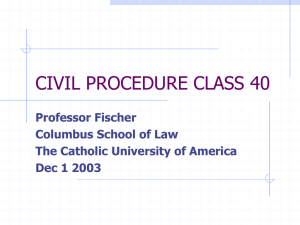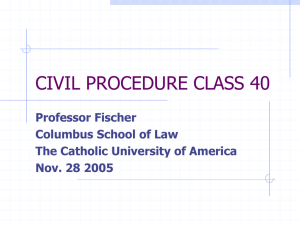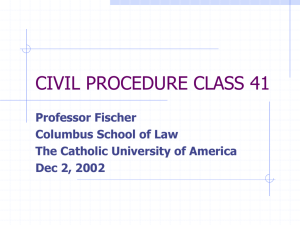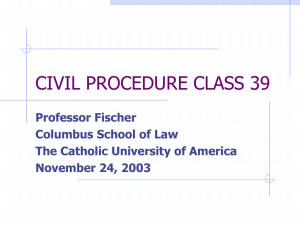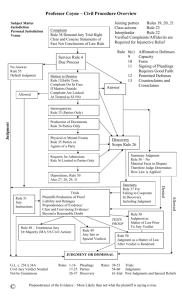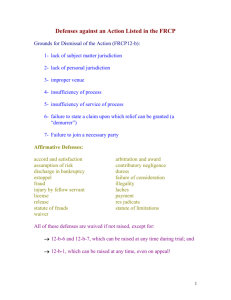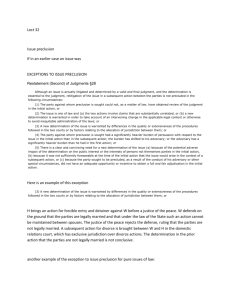civil procedure class 10 - The Catholic University of America
advertisement
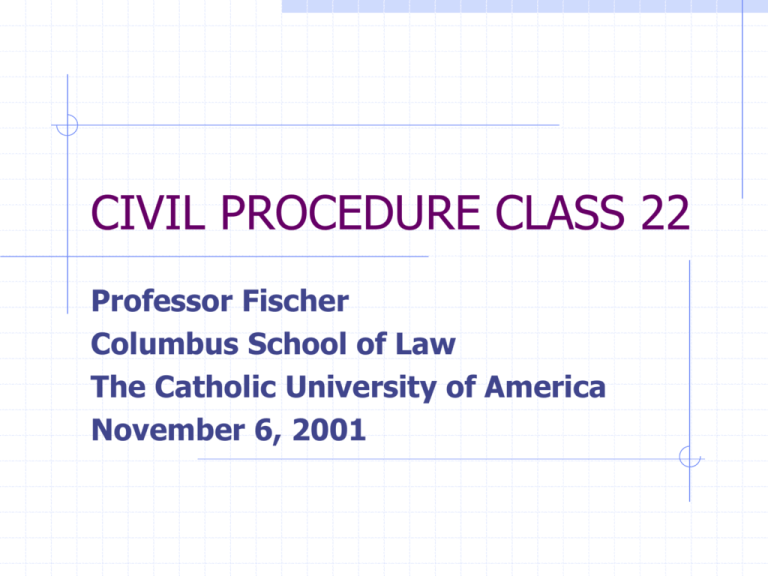
CIVIL PROCEDURE CLASS 22 Professor Fischer Columbus School of Law The Catholic University of America November 6, 2001 WRAP-UP OF LAST CLASS We finished our discussion of summary judgment as one type of pretrial adjudication We learned about voluntary and involuntary dismissals as another form of pretrial adjudication We began to learn about directed verdictsas yet another kind of preetrial adjudication WHAT WILL WE DO TODAY? Learn about new trial motions Learn about motions to vacate judgment Learn about claim preclusion (res judicata) Commence our study of issue preclusion (collateral estoppel) NEW TRIAL MOTIONS FRCP Rule 59 Must file motion for a new trial no later than 10 days after entry of judgment 59(b) A judge can grant a new trial sua sponte no later than 10 days after entry of judgment 59(d) What are the grounds for granting a motion for a new trial? GROUNDS FOR GRANTING A NEW TRIAL INCLUDE TRIAL ERRORS AND WRONG RESULT: Judge realizes he mistakenly admitted evidence over correct objection Newly discovered evidence Judge realizes she wrongly instructed jury over correct objection (see FRCP 51) Verdict against the weight of the evidence Excessive/inadequate verdict (see remittitur/additur above) ADDITIONAL GROUNDS FOR NEW TRIAL Improper conduct by counsel or judge Jury misconduct (e.g. verdict not unanimous/inconsistent) When can misconduct in a jury’s deliberations be grounds for a new trial? To what extent is what is said in the jury room admissible? See Fed. R. Ev. 606(b) at CB p. 510 Do you agree that Fed. R. Ev. 606(b) strikes an appropriate balance? Fed. R. Evid. 606(b) “a juror may not testify as to any matter or statement occurring during the course of the jury’s deliberation or to the effect of anything upon that or any other juror’s mind or emotions as influencing the juror’s mental processes in connection therewith . . .” Fed. R. Evid. 606(b) “. . .except that a juror may testify on the question whether extraneous prejudicial information was improperly brought to the jury’s attention or whether any outside influence was improperly brought to bear upon the juror.” PREJUDICE REQUIRED FOR NEW TRIAL UNDER RULE 59 Trial errors can only give rise to a new trial if they 1. Affect the substantive rights of the parties 2. Are not cured by the jury instructions 3. Were brought to the judge’s attention when they were made THE THIRTEENTH JUROR Can the judge order a new trial just because he disagrees with the jury’s verdict? THE THIRTEENTH JUROR Can the judge order a new trial just because he disagrees with the jury’s verdict? No – but he can order a new trial where the evidence is strong enough to rationally support the jury’s verdict but he believes that the verdict is against the clear weight of the evidence. He can consider the credibility of the witnesses. Of course, if the motion is granted, there will be a new trial and the JURY not the judge will be the trier of fact in the new trial. MOTIONS TO VACATE JUDGEMENT – RULE 60 FRCP 60 - judgments may be vacated both for clerical mistakes (60(a)) and other reasons set out in 60(b) Can you move for a j.n.o.v., new trial, and motion to vacate judgment at the same time? CLERICAL MISTAKES IN JUDGMENTS OR ORDERS FRCP 60(a) When can courts correct clerical mistakes in judgments, orders, or other parts of the record? What is a “clerical mistake”? CLERICAL MISTAKES IN JUDGMENTS OR ORDERS When can courts correct clerical mistakes in judgments, orders, or other parts of the record? At any time, on motion of party or on court’s own initiative What’s a clerical mistake? A minor, ministerial error arising from simple oversight or omission. NOT substantive factual or legal error 60(b): OTHER REASONS FOR VACATING JUDGMENT 2 categories of motions: 1. Motions based on some grounds are subject to a timing limitation that they must be made no more than 1 year after entry of judgment or order: which grounds are these? 2. Motions based on the other grounds for a 60(b) motion must just be made within a “reasonable time”. Which are these? 60(b):Motion must be made within 1 year of judgment/order CATEGORY 1: subject to timing limitation that they must be made no more than 1 year after entry of judgment or order: 1. Mistake, inadvertence, surprise, excusable neglect 2. Newly discovered evidence that by due diligence could not have been discovered in time to move for a new trial under 59(b) 3. Fraud, misrepresentation, or other misconduct of an adverse party 60(b) motions that must be made within a reasonable time 4. judgment is void (e.g. no personal jurisdiction, no subject matter jurisdiction) 5. Judgment satisfied, released or discharged 6. Catch all: any other reason justifying relief from the opeartion of a judgment in the interests of justice CATCH-ALL CATEGORY: FRCP 60(b)(6) “for any other reason justifying relief from the operation of the judgment” reserved for extraordinary circumstances Can the catch-all category be used for motions that would also fit within another 60(b) category? PRACTICE EXERCISE 20 CB p. 530 1. Would the defendant’s motion for directed verdict be allowed on the state claim for fraud under the civil service statute (clerks A-G)? 2. On the conspiracy claim? (clerks H-P) 3. On the section 1983 discriminatory claim? (clerks Q-Z) CLAIM PRECLUSION Also known as the doctrine of res judicata What is res judicata? What is the idea of “merger” and “bar” - see Restatement (2d) of Judgments s. 17 at CB p. 885 What is the purpose of res judicata? What does FRCP 8 (c ) say about res judicata? Why? NB. Res judicata can be waived! CLAIM PRECLUSION V. ISSUE PRECLUSION What is the basic difference between claim preclusion and issue preclusion? (see CB p. 884) What is the difference between claim preclusion and stare decisis? CLAIM PRECLUSION Does claim preclusion extend to claims only to claims that were made in the first lawsuit, or does it also extend to claims that could or should have been litigated in the first lawsuit? ELEMENTS OF RES JUDICATA 1. Prior suit that proceeded to a final valid judgment on the merits 2. Present suit arises out of same claim as the prior suit 3. Same parties to both suits, or parties are in privity FINAL VALID JUDGMENT ON THE MERITS VALID: To be valid, court rendering judgment must have valid subject matter and personal jurisdiction (if action dismissed for lack of p.j. or s.m.j., no claim preclusion for action brought in court with p.j. or s.m.j.) You can’t argue that a judgment is invalid simply because it was based on error, e.g. relying on unconstitutional statute FINALITY OF JUDGMENT There must be nothing left for judge to do but enter judgment Will a judgment determining liability be final for claim preclusion before damages have been adjudicated? What about dismissal of one of Ps claims, if the other claim is allowed to continue? Will the grant of preliminary injunctive relief bar an action for permanent injunctive relief for the same claim? Does an appeal destroy finality? JUDGMENT ON THE MERITS Disposition based on validity of Ps claim rather than technical procedural ground Is a judgment entered after a full trial a judgment on the merits? What about: 12(b)(6) dismissal? 12(b)(2) dismissal? Voluntary dismissal under FRCP 41(a)? A second voluntary dismissal under FRCP 41(a)? Dismissal for failure of prosecution under FRCP 41(b)? SAME CLAIM Federal courts employ a “transactional” approach to determining whether the claim in the first suit is the same as the claim in the second suit. Describe this “transactional” approach (See Restatement (2d) of Judgments s. 24 at p. 887 of CB) NOTE IT BASICALLY MIRRORS THE JOINDER RULES (see Rule 20) SAME PARTIES/PARTIES IN PRIVITY What is privity for the purposes of res judicata? Gonzalez v. Banco Central Corp. (1st Cir. 1994) What are the key facts? What is the procedural history? What is the issue on appeal? Did the Gonzalez plaintiffs win their appeal? Gonzalez: Final/Valid Judgment on the Merits Did the 1st Circuit find that there was a final judgment on the merits in the earlier Rodriguez suit? Gonzalez: Same Claim Did the 1st Circuit find that the claims asserted in the Rodriguez suit were the same as in the Gonzalez suit? Why or why not? Gonzalez: Same Parties/Parties in Privity Were the parties the same in the Rodriguez/Gonzalez suits? Why or why not? Did the 1st Circuit find that the parties in both suits were in PRIVITY? Why or why not? What are some examples cited by the 1st Circuit of when parties would be in privity? What is the doctrine of virtual representation? Why did the Gonzalez court find it did not apply? Gonzalez: Same Parties/Parties in Privity Why are courts unwilling to interpret privity broadly? Why does Judge Selya describe it as a “murky corner of the law?” (CB 903) ISSUE PRECLUSION Like claim preclusion, issue preclusion is part of the broader topic of former adjudication, that is, the effect of judgments on subsequent litigation Issue preclusion - precludes relitigation of a previously decided issue Also known as collateral estoppel CONTRAST CLAIM/ISSUE PRECLUSION Res judicata is a BLUDGEON; collateral estoppel is a scalpel Issue preclusion bars from relitigation ONLY issues that have been actually litigated and determined Issues can be barred from relitigation in some claims that do not involve same parties to previous litigation How is issue preclusion both broader and narrower than claim preclusion? ELEMENTS OF ISSUE PRECLUSION Same issue Actually litigated thus an admission is not enough for issue preclusion to apply Actually decided by a valid and final judgment Determination is essential to judgment Some courts require mutuality, i.e. same parties SAME ISSUE U.S. sues Student, alleging nonpayment on a student loan, signed on 3/12. Student defends on grounds of incapacity, alleging that his mental state on the day in question prevented him from entering into an enforceable contract. Student loses. U.S. sues Student alleging non-payment of a second student loan signed on the same day. Is the issue of student’s capacity precluded in the second action? ANOTHER HYPO Federal government criminally prosecutes an IRS agent, accusing her of stealing tax revenue. She is acquitted. Government then sues Agent in a civil action to recover funds allegedly embezzled in the same criminal acts. Agent seeks to invoke preclusion on the grounds that the previous case demonstrates acts did not occur. Does preclusion apply? What if the order of the cases are reversed? NEW EVIDENCE What if a party discovers new evidence on the issue. Should that party be allowed to relitigate the issue in a second action? ACTUALLY LITIGATED AND DECIDED Jessie and Bertha were driving in the car and collided with a train. They were both injured. B sued for her personal injuries, J sued for loss of consortium and personal services. B won damages; J recovered nothing. J brought a second suit seeking recovery for his personal injures. Assume the second suit permitted because no transactional test in that state. Did collateral estoppel apply to bar J from recovering in the second suit on the basis that the court had already decided the issue of whether J was contributorily negligent?. HYPO P sues D for copyright infringement and breach of contract. 1. Assume a jury trial. The jury renders a general verdict for D. Does collateral estoppel apply to bar P from relitigating issue of breach of contract? copyright infringement? 2. Now assume a brench trial. The judge finds both copyright infringement and breach of contract. Does collateral estoppel apply? NECESSARY TO THE JUDGMENT Add the following to the previous hypo. The first action was heard by a judge who determined: 1. RR not negligent 2. Jesse was contributorily negligent. Should the court in a subsquent claim hold Jesse precluded from relitigating both those issues? Or neither? HOULT CASE (3d Cir. 1998) What was Jennifer Hoult’s cause of action in the first action? What was the outcome of the first action? What is David Hoult’s cause of action in the second action? What is the procedural issue in the second action? How did the trial court rule? THE HOULT APPEAL Does the First Circuit affirm or dismiss Jennifer Hoult’s appeal? What is the First Circuit’s reasoning? MUTUALITY AND COLLATERAL ESTOPPEL Old rule: parties had to be the same New rule in federal court: Parklane Hosiery Co. v. Shore (1979) NOTE THAT PARKLANE applies only to federal courts. State courts are not obligated to follow Supreme Court. You will need to check the law carefully to see whether a jurisdiction has abandoned mutuality, and if so, to what extent. DEFENSIVE NON-MUTUAL COLLATERAL ESTOPPEL In Blonder-Tongue, the Supreme Court first endorses the use of nonmutual estoppel Key facts of Blonder-Tongue What is the policy justification for the Supreme Court’s reversal of its long-standing rule requiring mutuality? What is the difference between the use of collateral estoppel in Blonder-Tongue and in Parklane? DEFENSIVE NONMUTUAL ESTOPPEL Suit 1: P sues D1 (P loses on Issue A) Suit 1: P sues D2 (D2 pleads collateral estoppel to bar plaintiff from relitigating Issue A) PARKLANE HOSIERY V. SHORE Offensive nonmutual estoppel What are the key facts in Parklane? OFFNENSIVE NONMUTUAL COLLATERAL ESTOPPEL Suit 1: P1 sues D (D loses on Issue A) Suit 2: P2 sues D (new plaintiff invokes collateral estoppel to establish Issue A in her suit against D) What are the risks posed by offensive use of estoppel? SUPREME COURT IN PARKLANE Does the Supreme Court categorically endorse or reject offensive nonmutual collateral estoppel? What factors must lower courts consider? 4 PARKLANE FACTORS 1. Could nonparty have joined prior litigation? 2. Was subsequent litigation foreseeable at time of first suit? 3. Is judgment being relied on consistent with prior judgments against this D? 4. Are there any procedural opportunities available to D in second action that did not exist in the first that would lead to a different result?
